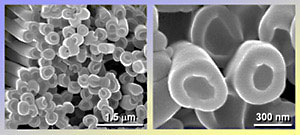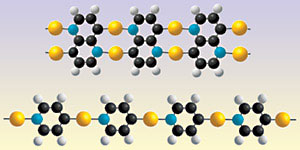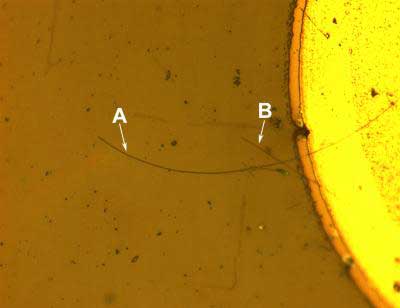Practical protein nanotubes
 Chemists in Japan have used a widely available protein and a straightforward technique to make nanotubes that can bind reversibly to oxygen, just like haemoglobin.
Chemists in Japan have used a widely available protein and a straightforward technique to make nanotubes that can bind reversibly to oxygen, just like haemoglobin.
May 31st, 2007
Read more
 Chemists in Japan have used a widely available protein and a straightforward technique to make nanotubes that can bind reversibly to oxygen, just like haemoglobin.
Chemists in Japan have used a widely available protein and a straightforward technique to make nanotubes that can bind reversibly to oxygen, just like haemoglobin.
May 31st, 2007
Read more A single gold atom might be able to serve as a versatile glue to bind together different kinds of monomers into completely unknown structures.
A single gold atom might be able to serve as a versatile glue to bind together different kinds of monomers into completely unknown structures.
May 31st, 2007
Read more Physicists have managed to make silicon shine red and blue in an alternating fashion.
Physicists have managed to make silicon shine red and blue in an alternating fashion.
May 30th, 2007
Read moreA new method for making the surface of metal stents highly nano porous by producing millions of nano bubbles underneath.
May 30th, 2007
Read moreCIELAP, the Canadian Institute for Environmental Law and Policy, held a one-day workshop in Toronto to explore policy considerations for nanotechnology.
May 30th, 2007
Read moreNew findings not only help us to understand the basic science of how lipid-like peptides interact with lipid molecules, but also may provide new strategies for the encapsulation and the delivery of biological active materials.
May 30th, 2007
Read moreRecent discoveries regarding the physics of ceramic superconductors may help improve scientists' understanding of resistance-free electrical power.
May 30th, 2007
Read moreUniversity of Alberta research team has combined two fields of study in nanotechnology to create a third field that the researchers believe will lead to revolutionary advances in computer electronics, among many other areas.
May 30th, 2007
Read moreResearchers have now developed a new MRI contrast agent using manganese oxide nanoparticles that produces images of the anatomic structures of mouse brain which are as clear as those obtained by histological examination.
May 30th, 2007
Read moreA new research center will allow competing biomedical companies to pool their funding to develop new medical technologies for minimally invasive surgical procedures.
May 29th, 2007
Read moreBetter magnetic storage devices for computers and other electronics could result from new work by researchers in Germany and the United States.
May 28th, 2007
Read moreStudy of a therapeutic peptide, Lanreotide, has revealed that this peptide can serve as a scaffold for the spontaneous formation of silica nanotubes by simple mixing with a silica precursor in water.
May 28th, 2007
Read moreNanotechnologies is a fancy name that excites millions of gullible simpletons who believe there's a Golconda behind every rinky-dink, small company in the nano-business.
May 27th, 2007
Read moreNew clinical protocols detailing how to prepare, process and quantify these tiny particles will arm laboratory physicians with the information they need to track biomarkers in cells and tissues.
May 25th, 2007
Read more Hydrothermal carbonization could be a useful process for reducing CO2 gases in the atmosphere.
Hydrothermal carbonization could be a useful process for reducing CO2 gases in the atmosphere.
May 25th, 2007
Read more Researchers have developed a technique to create tiny, highly efficient light-emitting diodes (LEDs) from nanowires.
Researchers have developed a technique to create tiny, highly efficient light-emitting diodes (LEDs) from nanowires.
May 25th, 2007
Read more